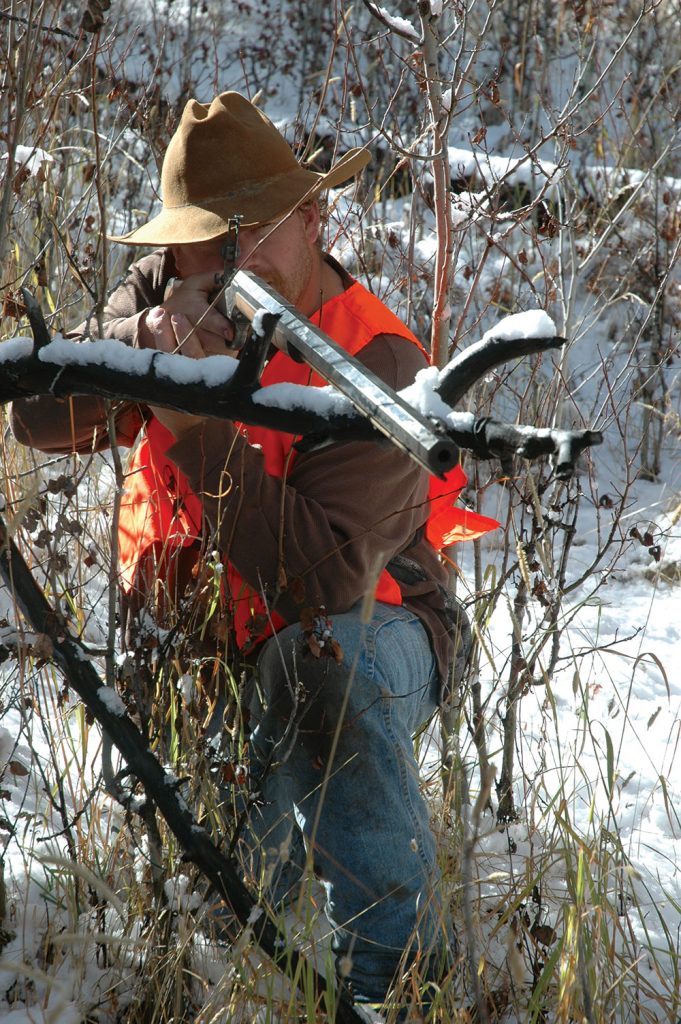Evidently I didn’t sound like a rabbit. Hunched against a basalt buttress on a hill catching every lick of winter’s wind, I’d stared long enough into the sweep of furrowed snow. Thin fawn heads of fescue sprang back stubbornly at each break in the blast. But the prairie lay empty. My feet were cold. I rose.
The coyote was standing. I can’t say how long it had watched me from my flank. No chance offhand. The wind and my tremors would send the shot awry. Slowly I sank to a knee, Winchester leveling at the same time. The crosswire wasn’t still, but at the snap of the .243, the coyote collapsed.
Kneeling may be the least-practiced of shooting positions. I say that having watched hunters drop to the wrong knee. Others keep the proper knee up, but don’t rest an elbow on it. None keep the front shin vertical nor their spine straight. I can’t recall when last I saw a hunter use a sling kneeling.
Such a pity! Kneeling is exceedingly useful! It puts your line of sight above tall grass and many bushes. Like sitting, kneeling gives you three points of ground contact, but it’s a faster position and much better for shooting along slopes or uphill. It permits some “swing” on moving targets. Because kneeling keeps your torso upright and your right arm free, you can cycle a rifle as fast as if standing.
Steady as prone? Good grief, no! Not even close. But years ago in four-position rimfire matches, my kneeling scores often equaled my sitting, and sometimes I cleaned the kneeling stage. While I shoot animals from prone when practical, with sitting my second choice, kneeling is more versatile than either. With a little practice you can wring from it 4-minute precision — enough for 150-yard shots on coyotes.
Haven’t tried kneeling lately? Here’s a refresher on what to do.
If you’re right-handed, place your right knee on the ground. Keep your left knee up, shin vertical beneath it. Sit back on your right foot, tail-bone on your heel, toes (the toe of your shoe) in full contact with the ground. The front of your foot, curled under, will start hurting after a short time, but practice will make the pain go away. Half your weight, in line with your spine, should rest on the toes and balls of that right foot. Allocate another third of your weight (including the rifle) to your left foot, flat on the ground and parallel with your right leg. The flat of your left elbow should contact the flat face of your left knee. So the point of the elbow falls just forward of the knee, not on it! Placing your elbow on top of your knee won’t steady your rifle. If you doubt it, try balancing a pool ball on that knee.
A shooting sling like Brownell’s Latigo helps control the rifle in any position that anchors your left arm — that is, every position except offhand. The loop, snugged above your left triceps, must be taut to the front swivel and slack from your arm to the rear swivel. The sling transfers the rifle’s weight from your wrist to the massive muscles in your left shoulder, which more easily handle the load. It also tugs the rifle into the pocket of your right shoulder. Sling tension and the rifle’s weight combine to press your left elbow against the face of your left knee, cementing that union.
What about the right knee? One of the legs of your bone tripod, it contacts the ground lightly, to bear only about 15 percent of the load.
You’ve no doubt seen kneeling hunters slouch. A slouch can relieve the pain you’ll feel in your right foot, but it’s too steep a price to pay for temporary comfort! When your body sags forward, it also rocks side to side as weight comes off the right heel. Your left leg cries out under the increased load. The rifle now points below the target, so you must move your left hand back on the forend, reducing control as you strain to nudge the barrel higher. The scope’s eyepiece is nearly kissing your brow. A second shot will be delayed as you wipe the blood from your lashes…
Keep that front leg vertical, half your weight on your tailbone! Your back and neck should be as straight as comfortable, head erect on the comb, eyes looking full ahead through the sight. Your position will then rely on bone support. Your muscles can relax. No quivering. No fatigue. Getting that right foot to stay bent comfortably under pressure takes practice. Try watching television from a kneeling position, resting as often as necessary. A kneeling roll helps. I made mine from an 8-inch-wide strip of carpet just long enough that when rolled tightly and taped, it snugs under my right ankle. Of course, you’ll not have it firing at game, but afield you’re unlikely to be in position long. Besides, excitement dulls pain!

A heavy Ballard gets help from an improvised rest. In its day, hunters commonly used shooting sticks.
One problem endemic to kneeling is a 3-to-9 wobble. Not even Olympic-class shooters can erase the rifle’s lateral sway. But you’ll reduce it if you keep your left foot parallel with your right leg. When you “drop into kneeling,” your left foot points naturally at or very near the target. It’s in line with the left thigh, not the right! To rein in rifle movement, release just enough pressure on that left foot to spin it on its heel, turning the toe to point where your right knee points.
If this trick seems to you heretical, you’re in good company! Every upright shooting position is properly built on bone. Muscles must remain relaxed or they tire and quiver. Turning the left foot inward does indeed put calf and thigh muscles of that leg under tension, in a slight twist. But after you turn your foot, you load that leg again, so the weight of the rifle and your body holds that twist. No effort required; the friction of your foot on the ground does the work. Your leg has now lost much of its tendency to rock
Full disclosure: I’ve muffed many shots from kneeling by yanking the trigger when the sight was returning from lateral wanderings. If your position is solid, the crosswire should spend enough time at or near center that you shouldn’t have to “time” a shot. Sometimes, on uneven terrain or when I’m winded, 3-to-9 wobble compels a “scheduled squeeze,” pressuring the trigger when the sight is on target, holding pressure when it leaves, adding more when it’s back on.
A few good kneeling shots come to mind. A whitetail buck trying to sneak away across a slash-choked draw paused briefly as I took a knee. The .270 bullet was on its way immediately and felled the deer where it stood. An elk striding through conifers gave me time to sit, but sitting would have been too static. From kneeling, I was able to track the animal and fire accurately when a wink of ribs appeared in a slot. The bull lunged, stumbled and dropped to my second bullet through the shoulder.
Kneeling delivered wonderful results once in Namibia, when I spied a fine eland quartering away at around 250 yards. Tall grass and bushes made a low position impossible. I slinged up, kept the vertical wire on the leading edge of the walking bull’s shoulder and fired. As the sound of the hit floated back, I’d already chambered a second round. Another Trophy Bonded bullet sped away. The eland faltered. Whuck! Another step and the bull was down. The entry holes were cleanly cut half an inch apart in the shoulder.
Predators we hunt are much smaller than eland and are commonly shot from a place of our choosing. Often we can shoot from sitting, sometimes prone. Still, kneeling can be useful. It’s steadier than offhand, and it’s important to note that well-aimed shots will come just as fast.
Age puts kneeling in a rosy light too. My back and thigh muscles, rebel against the crossed-leg and crossed-ankle sits that once shredded bull’s-eyes. I can still fall into kneeling easily, and hold it long enough when time is short and the grass is tall.







